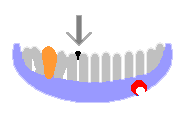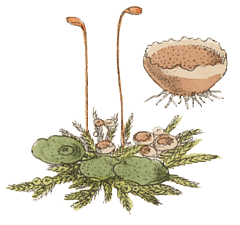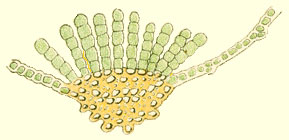|
Ecology – Bryophytes & fungi
Micro-niches
Many bryophilous fungi do not grow indiscriminately on their hosts, but at specific sites depending on the species of fungus. So, one species of fungus will be found only on the leaf midrib of a particular species of moss; another fungal species will be restricted to the stems; others may grow only on the spore capsules of some species of moss and so on.
The moss family Polytrichaceae provides some good examples of specific microhabitats just on the leaves of these mosses. In this family the leaves are quite complex. They have lamellae, which look like miniature walls running along the long axis of the leaf. The following pair of illustrations shows cross sections of leaves of the species Oligotrichum hercynicum, (on the left) with the few lamellae shown in green. The lamellae are the multi-celled columnar growths. The brown central area is the thickened central portion of the leaf and on either side are the leaf "wings", each just a single cell in thickness. On the right is Pogonatum urnigerum with numerous and densely packed lamellae. Each lamella is topped by a single brown-coloured cell. These cross-sections are across the long axis of the leaf, so you have to imagine that each lamella extends behind the screen and also extends out of the screen towards you. In the Polytrichaceae there is variation in leaf structure and these two illustrations give you just a hint of that variety![]() .
.
|
|
 The following diagram shows the micro-niches exploited by three of the ascomycetes that are found on members of the Polytrichaceae. It’s a very stylized depiction of a leaf cross-section. Bryorella cryptocarpa forms perithecia (one shown in orange) between the lamellae. The mature fruiting body has pushed aside the neighbouring lamellae. The arrowed black dot represents a perithecium of Dawsophila polycarpa, growing in the gap between the cells at the apices of two lamellae and on the underside of the leaf, you can find (in red) an apothecium of Potriphila neurogena
The following diagram shows the micro-niches exploited by three of the ascomycetes that are found on members of the Polytrichaceae. It’s a very stylized depiction of a leaf cross-section. Bryorella cryptocarpa forms perithecia (one shown in orange) between the lamellae. The mature fruiting body has pushed aside the neighbouring lamellae. The arrowed black dot represents a perithecium of Dawsophila polycarpa, growing in the gap between the cells at the apices of two lamellae and on the underside of the leaf, you can find (in red) an apothecium of Potriphila neurogena![]() .
.
Hymenoscyphus schimperi is another apothecial ascomycete but one in which the apothecia (under a millimetre in diameter) are found on the leaves of Sphagnum squarrosum, a moss that is widespread in the northern areas of the Northern Hemisphere. While the apothecia appear on the leaves, the points of infection are actually mucilaginous cells that are found in the nooks formed by the junctions of leaves and stems. For more details see the HYMENOSCYPHUS SCHIMPERI CASE STUDY.
The liverworts also support a good array of ascomycetes, some with very specific preferences. As an example, the perithecia of Calonectria frullaniae are found within liverwort perianths. A perianth is a somewhat tubular structure, formed by the fusion of two or three leaves, that protects the embryonic sporophyte. The fungal hyphae attack the sporophytic tissue and prevent normal capsule development. During sporophyte development there would be considerable nutrient flow from the gametophyte to the developing sporophyte, an ideal site for fungal exploitation. Calonectria frullaniae does not attack the gametophyte![]() .
.
![An Australian Government Initiative [logo]](/images/austgovt_brown_90px.gif)




